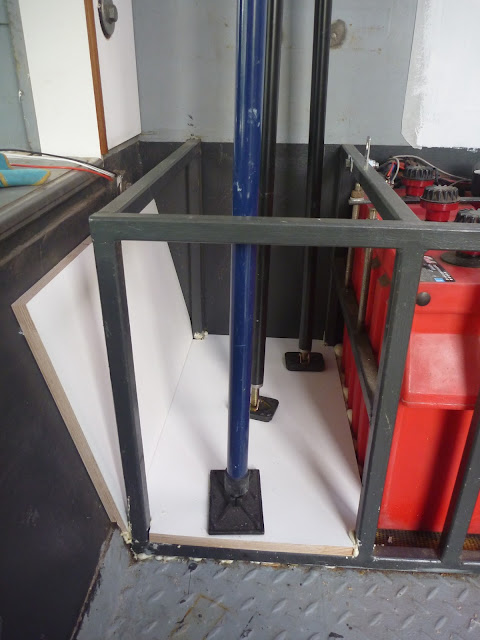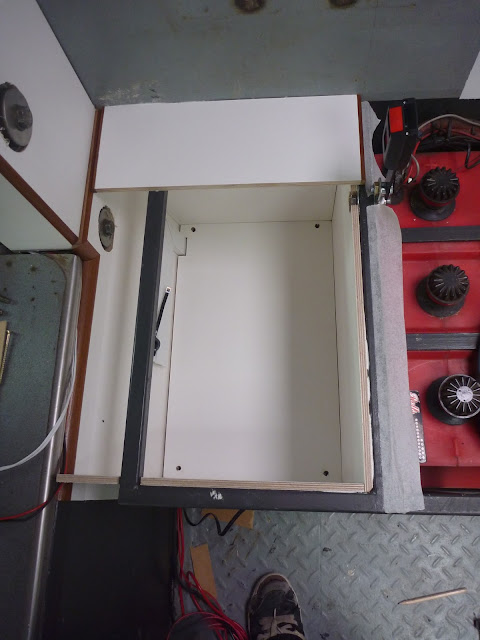I built the basic frame for the seat a long time ago, in fact it was one of the first things that I did in Jim once I'd stripped out the evidence of Jim's former life as a cash-in-transit truck for Brinks. The place now occupied by the bench seat, previously housed a single coach style passenger seat for a third crew member, and an Eberspacher D2 air heater which I moved underneath the truck. I got a good deal on some Rolls Surette 5000 series batteries, and needed somewhere to put them, both permanently when Jim's transformation is complete, and temporarily to get them out of the way whilst I worked on Jim. Below is what the frame looked like soon after I had finished it; it is fabricated from 25mm box section steel as I did not like the idea of 400kg of batteries performing rapid physical rearrangement of Naomi, Boris, me and everything else, in the event of an accident.
I then filled it with batteries and put a piece of plywood across the top, and this is pretty much how it stayed until I restarted work on it a couple of weeks ago.
The first thing I did, was to fit the mounting brackets for a seatbelt. The two bench seats will be able to comfortably seat four people between them, but as hard as I tried I could not find any sensible way of mounting more than one seat belt without severely restricting access to lockers, boxes or cupboards that I need to access regularly. Having a third seat belt in the truck is great, but having six would have been pretty useful. As it is, the seatbelt retractor and buckle both need to be removed for me to access the batteries for topping up the water, but I cannot moan too much about removing two bolts to perform a task which only needs doing once a month or so.
Both brackets came with the Securon seat belts, and so with the exception of the pillar loop mount, the whole installation uses certified components.
Not having a pillar on which to mount the upper loop, I welded a stud to Jim's wall.
Following the last blog post, I was keen to find a home for the amplifier which would allow me to finally get the sound system working. The offside bench seat is largely divided into two sections, the right side which houses the battery bank, and the left side which will house the amplifier, the mains inverter, and a small storage box. Naturally I started work on the left side first.
The work started by cladding out the inside of the frame using more WISA Multiwall. Most of the box is made from 9mm material, but the section butting up to the front wall of the truck is clad in 18mm, so that I can securely fix the 9kg inverter using wood screws, and without having to weld mounting studs in place. The clamps are holding the panel down, as I sprayed expanding foam under the piece to provide some insulation in an attempt to stop anything left in the box from going mouldy.
I continued in the same way, until I had a sealed box in which the amplifier could be mounted.
Whilst I do value the important role and functional (ugly) appearance of the amplifier, I didn't want it to make a useful storage space unusable, and so I put battens around the perimeter of the box so that the amplifier could be covered with a lid, and items can be stored in the box without covering the amplifier (which gets hot, and has high current cables going into it).
To prevent the amplifier overheating like a fat man in a sauna, I left the front panel short, so that the heat expelled can escape.
I then mounted a small remote switch for the inverted on the outside of the box. The inverter will be easy to access, being mounted on the wall of the storage box, but the indicator LED, and function button are on the underside of it, and will be difficult to use without hanging upside down from the roof and pressing the button with my tongue. The Studer AJ inverter that I am using is nicely finished, powder coated in silver and with rounded edges; the remote in contrast is made from magnolia plastic, and I suspect that the designer went to the same school as the designers of caravan bathrooms.
I boxed around the inverter remote, and amplifier, and then clad the outer wall of the bench in more plywood. I used 18mm material here, and left a strip in the middle, which will allow me a channel to run cables and cover them in a way which will allow me future access if needed.
I then mounted the inverter, and relished in the novelty of being able to use powertools in the truck without running a cable. The inverter will output 1000w continuously and will allow much higher currents for a short period to allow motors to start. The lid of the box will not be sealed in any meaningful way, but I will have to keep an eye on the inverter to check that it does not get too hot.
I then got busy with the teak mouldings again, covering all exposed plywood with varnished teak quadrants and stop mouldings.
The main fuses for the inputs and outputs from the battery bank are adjacent to the battery bank, in the electrical cupboard. Whilst the inverter is also adjacent to the battery bank (to keep cable runs short), it is on the other side of the batteries, and so to avoid having to run a 2m cable and use oversize cable to counteract voltage drop, I mounted a separate fuse for the inverter, above the remote switch.
To allow me to use the cable conduit I had cut out of the bench cladding, I cut a large hole out of the bottom of the electrical cupboard, and tidied the edges with trim to prevent cable chafing.
Like the nearside seat, I had to cut awkward recesses out of the lid, to allow it to clear the bolts holding the cab to the box.
With the seat largely complete (I still need to cover the wiring conduit), I ran temporary wires for the amplifier and got some glorious noise into Jim at long last. The good noise was accompanied by some bad noise (hissing) and I only got to enjoy 2 days of music, before the new Bosch headunit failed and started popping fuses. It is now being repaired under warranty. I'm not sure what caused the hissing, but I suspect it is related to the length of RCA cable (5m) between the headunit and amplifier. I'll experiment more with hiss reduction when the headunit returns from Autosound, the UK distributor and repair centre for Bosch truck and bus audio components.




















No comments:
Post a Comment